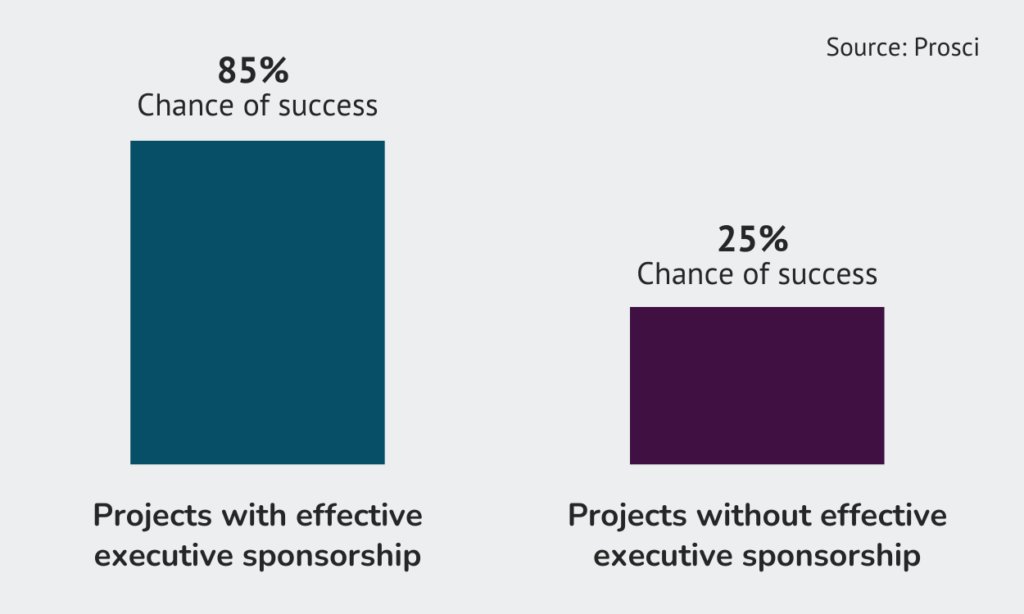Blog Posts
Focus Areas for M&A Success in 2024 and Beyond
4 minute read
4 minute read
Organizational change initiatives fall into two categories—ones that require employees to be on board, and ones that don’t.
For minor projects, such as system-wide software updates, minimal action is required from the user for the change to be successfully executed. However, for large-scale changes, such as implementing a new ERP system or a shared services relocation, employee and stakeholder buy-in is crucial.
Despite its importance, user adoption can be difficult to achieve. Keep reading as we address common challenges to change adoption and how to overcome them for transformation success.
Executives and business leaders are essential to successful change adoption. McKinsey research has found 72% of companies with failed transformation initiatives identify management behavior and employee resistance as major roadblocks. Prosci research on this trend also shows effective executive sponsorship increases a project’s chance of success from 25% to 85%.
Executive support and sponsorship is needed to:
Company leaders play a vital role in breaking down employee resistance and opening the doors to user adoption. The key, however, is sustained support and sponsorship. Executives must do more than sign a check and make the initial announcement. Demonstrating ownership and transparency during the entire project lifecycle will encourage employees to transform with the initiative, not against it.

Humans are naturally resistant to change, so employees are going to be skeptical about the initiative from the get-go. Pair skepticism with confusion, and you have a recipe for failure.
Research shows only 68% of senior managers understand the reasons for major organizational change, a number which drops to 53% for middle managers and 40% for frontline supervisors.
Before the project can launch, business leaders need to conduct assessments and prepare resources to ensure managers and supervisors fully understand the transformation initiative.
The goal is equipping managers with the knowledge to answer these crucial employee questions:
Executives may have a clear vision and understanding of the transformation, but a vision means nothing if the rest of the organization’s view is blurry. By creating a comprehensive change guide, leaders can count on managers to clear up confusion and drive the initiative forward with their team.
Read: Why Do Business Transformations Fail?

When a transformation initiative is announced, it’s often surprising—and sometimes downright shocking—to the employees it impacts.
Gartner research has found 73% of change-affected employees report experiencing moderate to high stress levels, and those suffering from change-related stress perform worse than the average employee. A dip in motivation and performance greatly hinders a user’s willingness to accept a new change or initiative.
The good news is a comprehensive communication plan can help alleviate organizational anxiety, allowing employees to be more open minded. Our Change Management Checklist outlines the steps for an effective communication plan, including:
1. Establishing a consistent communication schedule
2. Sharing transparent progress reports at each stage of the journey
3. Fostering two-way communication and adjusting the plan accordingly
When it comes to change, clear communication between management and employees helps develop trust, align goals, and promote productivity.
Read: Supply Chain Trends & Insights Report: Transformation

There’s a common saying in change management that “change starts at the top but happens at the bottom.” This is especially true in the implementation stage.
Though transformations are initiated by leadership, the CEO isn’t going to be leading the charge at every step. Most likely, a certain task force or department will be responsible for executing the new changes, especially with digital transformations. However, internal employees may lack the necessary skills to get the job done.
Working with outside resources—such as change management or implementation consultants—will provide organizations with specialized expertise to get it right the first time.
Consultants with experience implementing new technologies will be able to overcome common digital transformation challenges such as outdated systems, information silos, inefficient processes, and inadequate technical expertise.
Smoother implementation leads to a faster time to achieve ROI, which puts your company one step closer to becoming a transformation success story.
At Catena Solutions, we know successful change management hinges on user adoption. When you partner with us, we ensure change initiatives become a competitive advantage, not a distraction. Our team of specialized consultants ensure employee and stakeholder buy-in for all transformation initiatives.
Learn more about our Change & People solutions here.